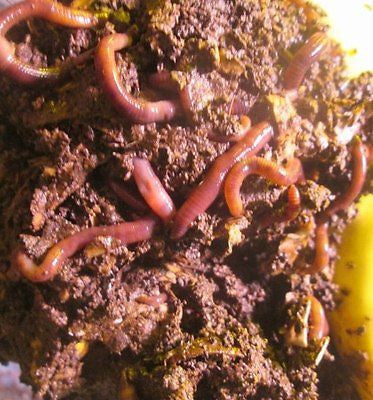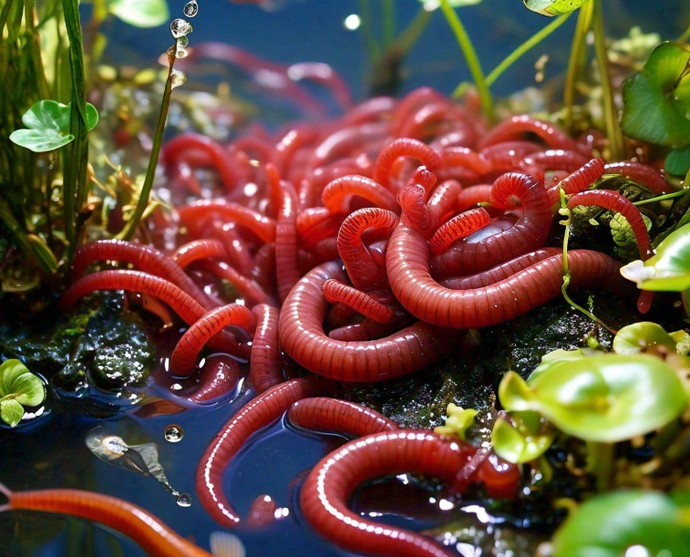Composting-optimized red worms: Why they matter for gardens
Composting-optimized red worms: Why they matter for gardens
Blog Article
Exactly How Red Wigglers Can Boost Your Organic Waste Recycling
Red wigglers stand for an essential part in enhancing organic waste recycling, properly transforming daily kitchen area scraps and yard debris into useful worm spreadings. This process not only reduces the volume of waste sent out to land fills however also enriches dirt vitality, promoting much healthier plant growth without the requirement for synthetic plant foods. Comprehending the ins and outs of establishing a vermicomposting system and the optimal take care of these worms can dramatically magnify the advantages. Yet, the inquiry stays: how can one successfully incorporate this method into their regular to make best use of impact?

Advantages of Red Wigglers
Red wigglers, a kind of composting earthworm, deal countless advantages that make them important in natural waste recycling. These worms can process cooking area scraps, garden waste, and even paper products, transforming them into nutrient-rich castings.
Furthermore, red wigglers improve soil oygenation and drainage with their tunneling activities, promoting a healthier origin environment for plants. Their spreadings are abundant in useful bacteria and vital nutrients, fostering robust plant growth and boosting soil framework (red wigglers). Moreover, the usage of red wigglers in composting is an ecologically friendly choice to chemical fertilizers, which can have damaging adverse effects.
Additionally, vermicomposting with red wigglers is a low-maintenance and efficient method of recycling natural waste, making it easily accessible for families and communities alike. Their rapid recreation price ensures a constant supply for ongoing composting initiatives, additionally intensifying their advantages. Generally, red wigglers offer as a crucial part in lasting waste management and soil enhancement practices.
Establishing Up a Vermicomposting System
Creating a reliable vermicomposting system calls for mindful preparation and factor to consider of numerous elements that add to its success. The structure of an effective system starts with selecting an ideal container. Options vary from industrial containers to homemade options, yet it is important that the container is well-ventilated and properly sized to accommodate the variety of red wigglers.
Next, the selection of bed linens product is crucial. Suitable bed linens consists of shredded newspaper, cardboard, or coconut coir, which provides both an environment and a resource of carbon for the worms. The bed linens should be moistened yet not extremely wet to avoid anaerobic problems.
Keeping the optimal atmosphere is essential. Red wigglers grow in temperatures in between 55 ° F and 77 ° F(13 ° C to 25 ° C )and require a pH level around neutral. Keeping an eye on moisture degrees is additionally crucial, as way too much dampness can bring about smell troubles, while inadequate can dry out the worms.
Finally, putting the vermicomposting system in a shaded location protected from direct sunshine will certainly aid preserve a secure setting. With these considerations in mind, one can successfully set up a flourishing vermicomposting system that improves organic waste recycling.
What to Feed Red Wigglers
Feeding red wigglers the ideal materials is fundamental to keeping a healthy and balanced vermicomposting system. These worms flourish on a diverse diet primarily composed of organic issue, which includes vegetables and fruit scraps, coffee grounds, crushed eggshells, and shredded paper. It is important to avoid feeding them meat, dairy, oily foods, or any type of processed products, as these can create smells, bring in insects, and cause an unhealthy setting.
A well balanced diet plan for red wigglers promotes optimum food digestion and nutrient manufacturing. Go for a mix of green materials, high in nitrogen, such as veggie peels and turf cuttings, and brown materials, abundant in carbon, like dried out leaves and cardboard. This equilibrium guarantees a sustainable food resource while preserving wetness levels in the worm bin.
Additionally, it is advisable to chop or shred bigger scraps to speed up disintegration and make the food much more easily accessible to the worms. Routinely checking the intake rate will help establish the suitable quantity to feed, stopping overfeeding and maintaining a prospering ecosystem. By giving an ideal diet plan, you not only sustain the health of red wigglers yet likewise enhance the efficiency of your vermicomposting initiatives.
Keeping Your Worm Container
To make certain the health and efficiency of your vermicomposting system, keeping your worm bin is important. Regular monitoring of wetness degrees is important; the bed linen needs to perspire however not soggy. If it comes to be as well damp, excess moisture can result in anaerobic problems, damaging your worms. Alternatively, if it is too dry, worms may come to be non-active or pass away.
Extreme temperature levels can stress or eliminate your worms. To attain this, position your container in a climate-controlled setting away from direct sunshine or warmth resources.
Aeration is essential for oxygen flow. Delicately transforming the bed linen with a garden fork every few weeks will assist aerate the product and stop compaction. Additionally, be cautious regarding the container's odor. A foul odor may show overfeeding or an inequality in the carbon-to-nitrogen ratio. If this takes place, decrease feeding and include even more carbon-rich products like shredded paper or cardboard.
(eisenia fetida worms for sale)
Using Worm Castings in Horticulture

Worm castings, frequently described as "black gold" by garden enthusiasts, are a highly healthy natural plant food that can substantially enhance dirt wellness and plant growth. These spreadings are created by red wigglers as they digest natural matter, resulting in a rich, dark, crumbly compound including advantageous microorganisms.
Including worm spreadings right into yard dirt improves its framework, aeration, and wetness retention, developing an optimal setting for origin advancement. The high nutrient content of worm spreadings, consisting of nitrogen, phosphorus, and potassium, adds to vigorous plant growth and enhanced yields. Additionally, worm castings include crucial trace minerals and enzymes that promote the general wellness of plants, allowing them to much better endure bugs and illness.
Worm castings can be used straight to the soil or mixed into potting mixes for container gardening. A thin layer spread over yard beds or contributed to compost heap can likewise improve the microbial activity and nutrient profile of the garden compost. As a lasting and green fertilizer alternative, worm castings sustain organic gardening practices while minimizing dependence on synthetic plant foods, thereby fostering a healthier ecosystem.
Conclusion
To conclude, the assimilation of red wigglers right into natural waste recycling methods offers a sensible option for boosting dirt wellness and promoting lasting gardening strategies. By effectively disintegrating kitchen area scraps and yard waste, red wigglers contribute to nutrient-rich worm castings that improve soil oygenation and wetness retention. have a peek at this site This environmentally friendly method not only lowers landfill contributions but also diminishes the dependence on chemical plant foods, inevitably fostering much healthier communities and accountable waste management practices.
Report this page